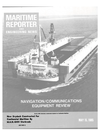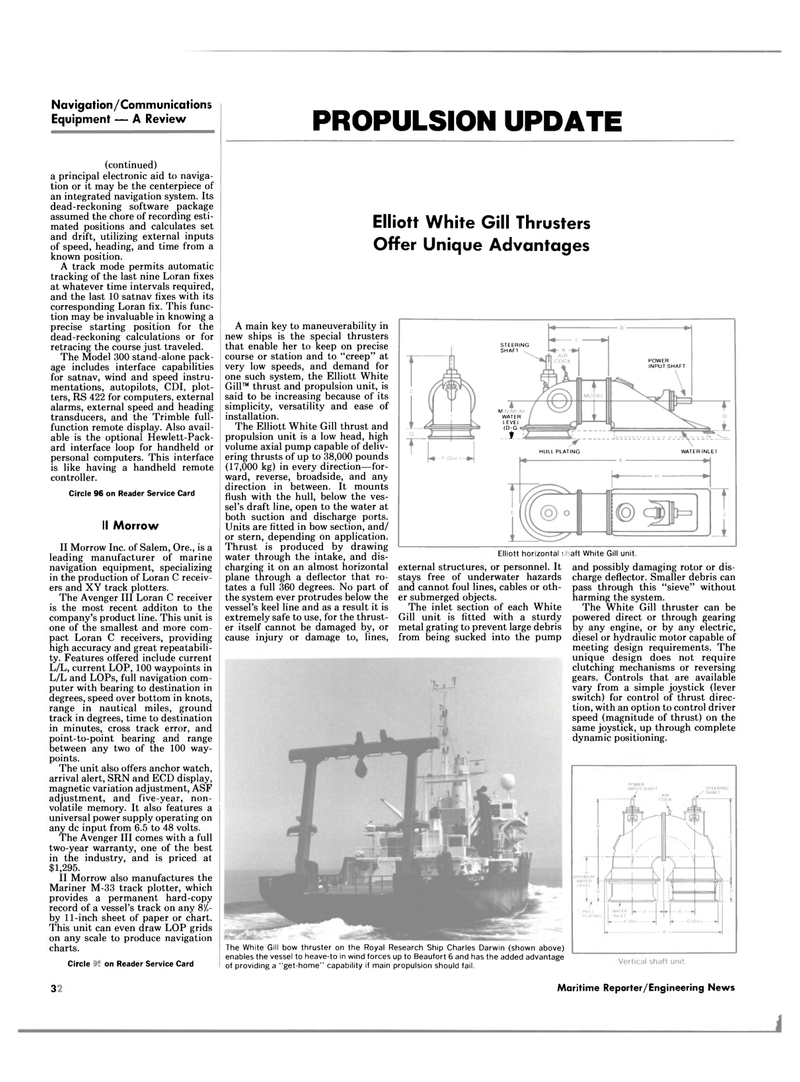
Page 32: of Maritime Reporter Magazine (May 15, 1985)
Read this page in Pdf, Flash or Html5 edition of May 15, 1985 Maritime Reporter Magazine
Navigation/Communications
Equipment — A Review (continued) a principal electronic aid to naviga- tion or it may be the centerpiece of an integrated navigation system. Its dead-reckoning software package assumed the chore of recording esti- mated positions and calculates set and drift, utilizing external inputs of speed, heading, and time from a known position.
A track mode permits automatic tracking of the last nine Loran fixes at whatever time intervals required, and the last 10 satnav fixes with its corresponding Loran fix. This func- tion may be invaluable in knowing a precise starting position for the dead-reckoning calculations or for retracing the course just traveled.
The Model 300 stand-alone pack- age includes interface capabilities for satnav, wind and speed instru- mentations, autopilots, CDI, plot- ters, RS 422 for computers, external alarms, external speed and heading transducers, and the Trimble full- function remote display. Also avail- able is the optional Hewlett-Pack- ard interface loop for handheld or personal computers. This interface is like having a handheld remote controller.
Circle 96 on Reader Service Card
II Morrow
PROPULSION UPDATE
Elliott White Gill Thrusters
Offer Unique Advantages
II Morrow Inc. of Salem, Ore., is a leading manufacturer of marine navigation equipment, specializing in the production of Loran C receiv- ers and XY track plotters.
The Avenger III Loran C receiver is the most recent additon to the company's product line. This unit is one of the smallest and more com- pact Loran C receivers, providing high accuracy and great repeatabili- ty. Features offered include current
L/L, current LOP, 100 waypoints in
L/L and LOPs, full navigation com- puter with bearing to destination in degrees, speed over bottom in knots, range in nautical miles, ground track in degrees, time to destination in minutes, cross track error, and point-to-point bearing and range between any two of the 100 way- points.
The unit also offers anchor watch, arrival alert, SRN and BCD display, magnetic variation adjustment, ASF adjustment, and five-year, non- volatile memory. It also features a universal power supply operating on any dc input from 6.5 to 48 volts.
The Avenger III comes with a full two-year warranty, one of the best in the industry, and is priced at $1,295.
II Morrow also manufactures the
Mariner M-33 track plotter, which provides a permanent hard-copy record of a vessel's track on any 8'/- by 11-inch sheet of paper or chart.
This unit can even draw LOP grids on any scale to produce navigation charts.
Circle 172 on Reader Service Card
The White Gill bow thruster on the Royal Research Ship Charles Darwin (shown above) enables the vessel to heave-to in wind forces up to Beaufort 6 and has the added advantage of providing a "get-home" capability if main propulsion should fail.
A main key to maneuverability in new ships is the special thrusters that enable her to keep on precise course or station and to "creep" at very low speeds, and demand for one such system, the Elliott White
Gill™ thrust and propulsion unit, is said to be increasing because of its simplicity, versatility and ease of installation.
The Elliott White Gill thrust and propulsion unit is a low head, high volume axial pump capable of deliv- ering thrusts of up to 38,000 pounds (17,000 kg) in every direction—for- ward, reverse, broadside, and an> direction in between. It mounts flush with the hull, below the ves- sel's draft line, open to the water at both suction and discharge ports.
Units are fitted in bow section, and/ or stern, depending on application.
Thrust is produced by drawing water through the intake, and dis- charging it on an almost horizontal plane through a deflector that ro- tates a full 360 degrees. No part of the system ever protrudes below the vessel's keel line and as a result it is extremely safe to use, for the thrust- er itself cannot be damaged by, or cause injury or damage to, lines,
Elliott horizontal : external structures, or personnel. It stays free of underwater hazards and cannot foul lines, cables or oth- er submerged objects.
The inlet section of each White
Gill unit is fitted with a sturdy metal grating to prevent large debris from being sucked into the pump aft White Gill unit. and possibly damaging rotor or dis- charge deflector. Smaller debris can pass through this "sieve" without harming the system.
The White Gill thruster can be powered direct or through gearing by any engine, or by any electric, diesel or hydraulic motor capable of meeting design requirements. The unique design does not require clutching mechanisms or reversing gears. Controls that are available vary from a simple joystick (lever switch) for control of thrust direc- tion, with an option to control driver speed (magnitude of thrust) on the same joystick, up through complete dynamic positioning.
STEERING
SHAF I
M
WATER
L EVf I (D-G 1
POWER
INPUT SHAFT
HULL PLATING WATERINLFI 30 Maritime Reporter/Engineering News

 31
31

 33
33
